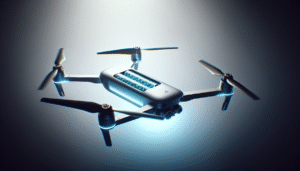Wondering whether it’s truly safe to fly on a full battery? One would think that the fullness of a battery isn’t something you need to worry about, but as it turns out, there’s more to it than meets the eye. The complex world of technology often leaves us with more questions than answers, and this intriguing topic provides no exception. Buckle up as we tackle this modern-day conundrum from an expert-driven perspective, aiming to provide clarity—and maybe a little bit of comfort—along the way.

Understanding Battery Basics
Before diving into the safety aspects of flying on a fully charged battery, it’s essential to have a solid grasp on what a “battery” is. A battery is, essentially, a device that stores energy and supplies it as needed. The key to its operation involves a chemical reaction that either absorbs or releases electrons to generate an electric current.
Types of Batteries
The world of batteries is as varied as the myriad devices they power. Understanding the different types can provide much-needed insight:
- Lithium-Ion Batteries: These are commonly used in smartphones, laptops, and electric vehicles. Known for their high energy density, they pack a lot of power into a small space.
- Nickel-Metal Hydride Batteries: Often found in older video cameras and power tools, these batteries offer a balance between cost and performance.
- Lead-Acid Batteries: These are typically used in cars and are known for their reliability and low cost. They’re considerably heavier and bulkier than lithium-ion batteries.
- Nickel-Cadmium Batteries: Common in older portable electronics, these batteries have lower energy densities compared to alternatives.
Charging Cycles and Battery Life
A charging cycle refers to the process of charging a battery from 0% to 100% and then using it until drained. The life of a battery is typically measured in cycles. Over time, the capacity of a battery diminishes, and it can hold less charge.
Safety Mechanisms
Modern batteries are equipped with several safety mechanisms. Sensors and software within the device manage the charge, ensuring it doesn’t go beyond certain limits, which could lead to overheating or other malfunctions. However, these mechanisms are not infallible.
The Pros of Flying on a Full Battery
Let’s consider the appealing aspects first. A fully charged battery means that you’re starting your journey with the most available power. It’s like beginning a road trip with a topped-off gas tank.
Maximizing Travel Time
For those traveling with devices, a full battery ensures that laptops, tablets, and phones can remain operational for as long as possible. This is especially crucial on long flights where charging options might be limited or unavailable.
Reduced Anxiety
Knowing your device is fully charged can alleviate the anxiety of being “stranded” without power mid-flight. Whether you’re using entertainment apps, working on a presentation, or simply comforting a restless child with cartoons, a full battery offers peace of mind.
Consistency in Performance
Devices operate optimally when they’re not in low-power modes. A fully charged battery can ensure that performance remains consistent throughout the flight, avoiding any slowdowns or technical glitches.

The Cons of Flying on a Full Battery
Despite the advantages, there are noteworthy concerns that experts caution against when it comes to boarding with a fully charged battery.
Overheating Risks
One of the primary risks of a fully charged battery is overheating. Modern electronics are designed to prevent this, but the risk isn’t entirely eliminated. Overheating can lead to battery swelling or, in extreme cases, combustion.
Stress on Battery Cells
Charging a battery to its maximum capacity repeatedly can place stress on the battery cells, reducing the device’s overall battery life. This might not be immediately evident, but over time, the device will hold less charge.
Safety Regulations
There are safety concerns, especially with lithium-ion batteries. Airlines impose strict regulations about carrying spare batteries because they can pose a fire hazard. While devices should have safety features, malfunctions can occur.
What Experts Say About Battery Safety
To provide a comprehensive view on this topic, let’s delve into expert opinions and what they advise regarding fully charged batteries, particularly in an aviation environment.
Industry Perspectives
The aviation industry and consumer electronics experts concur on certain guidelines:
| Aspect | Expert Opinion |
|---|---|
| Safety | Regulations require batteries to adhere to specific safety standards. Always charge to 80% where possible to minimize risks. |
| Battery Health | Frequent full charges can degrade batteries faster. Aim for 20-80% charge. |
| Device Usage | Avoid using highly demanding applications when devices are fully charged. |
Recommended Practices
Experts advocate for several practices to enhance safety and battery longevity:
- Avoid Extreme Temperatures: Always keep devices within recommended temperature ranges.
- Charge Wisely: Use manufacturer-approved chargers and unplug once fully charged.
- Regular Inspections: Check devices regularly for swelling or unusual odors.
- Smart Charging: Consider using smart charging tools that prevent full charges.
Real-life Incidents
There have been isolated cases where devices caught fire due to battery malfunctions. These incidents highlight the importance of adhering to safety recommendations and being diligent with device upkeep.
Maintaining Battery Longevity
Now that we’ve discussed pros, cons, and expert opinions, how do we maintain battery longevity while keeping safety in mind?
Charging Habits
Forming good charging habits can significantly extend the life of your battery:
- Partial Charging: Rather than charging fully then discharging completely, aim for partial charges.
- Battery Cycles: Avoid using devices in ways that drain their batteries quickly.
- Sleep Mode and Power Off: During flights, use sleep mode or turn devices off if not in use.
Device Care
Practicing diligent device care will help ensure your battery remains safe and functioning:
- Regular Updates: Software updates often include battery optimization features.
- Inspection: Frequently check the device for any signs of wear or damage.
- Appropriate Tools: Use the right cables and plugs to minimize damage.
Conclusion
Having navigated through the maze of battery safety, it becomes apparent that boarding with a full battery isn’t strictly hazardous, but being mindful of best practices can make a significant difference in safety and longevity. The key lies in respecting the delicate dance between power, safety, and convenience, all while enjoying the jet-setting lifestyle most of us cherish. Safe travels and smart charging!


